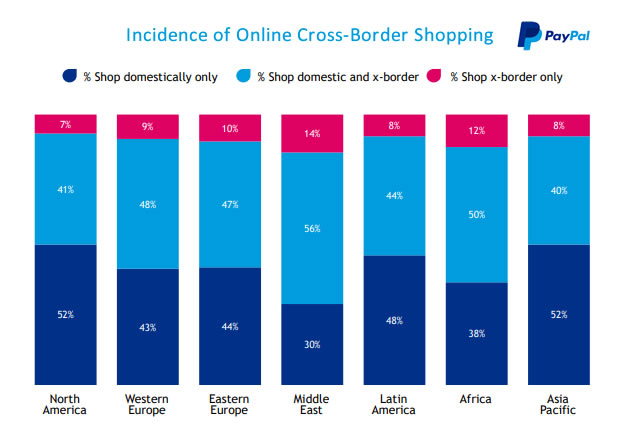Cross-Border Consumer Research 2018 | PayPal
Warning: Undefined array key 0 in /home/dmc/public_html/wp-content/themes/DMC/single-report.php on line 19
Warning: Attempt to read property "name" on null in /home/dmc/public_html/wp-content/themes/DMC/single-report.php on line 19
|
Global
The internet and the adoption of new communication technology have made it possible for consumers to transcend time and place borders. Cross-border e-commerce, which refers to the digital purchasing on foreign sites, is risen steadily among both retailers and consumers. In the same context, PayPal in its 2018 Cross-Border Consumer Research digs into how and why shoppers in 31 markets worldwide buy on foreign e-commerce sites.
Key Findings on Cross-Border E-Commerce
- The United States and China grabbed the biggest online and cross-border commerce size, while Japan and India are the fastest growing markets.
- Ireland leads all surveyed countries in terms of the adaption of cross-border shopping with a rate of 19%, followed by Belgium and Israel at the same level (16%).
- In contrast, Japan is much more likely than any other country to shop domestically only.
- On the level regions, consumers in the Middle East are more likely to shop online on foreign sites with a rate of 14%, followed far from Eastern Europe (10%) and then Western Europe (9%).
How and Why Consumers Shop Online Across-Borders
- Desktop/laptop/notebook is the most used device to make online cross-border purchases, followed by smartphone devices.
- The Asia Pacific and the Middle East ranked the top in terms of the use of smartphone device for online cross-border purchasing (32% and 31%, respectively).
- China, the US, and then the UK are the most popular cross-border destinations for global shoppers (26%, 21%, and 14%, respectively).
- Clothing and apparel is the most popular category for cross-border purchases (68%), followed far by Consumer Electronics (53%) and Toys (53%).
- 72% of online cross-border shoppers indicated that betters prices is the top reason for shopping in other countries.
- Cheapest total cost (including shipping), free shipping, security and the availability of items cannot be founded locally are the top factors drive international sales amongst cross-border shoppers.

A Graph Shows the Proportion of Incidence of Online Cross-Border Shopping Per Region – 2018
Methodology:
Data were driven from 34,052 consumers aged 18 or over across 31 markets. Interviews were conducted online between 13th March and 1st May 2018.

PayPal
Financial services
PayPal is the safer, easier way to pay and get paid online. The service allows anyone to pay in any way they prefer, including through credit cards, bank accounts, PayPal Smart Connect or account balances, without sharing financial information. PayPal becomes a global leader in online payment solutions with more than 203 million accounts worldwide.
Available in 202 countries and 25 currencies around the world, PayPal enables global e-commerce by making payments possible across different locations, currencies, and languages.
Located in San Jose, California, PayPal was founded in 1998.
Warning: Undefined array key "sidebar_ads" in /home/dmc/public_html/wp-content/themes/DMC/functions/helpers.php on line 824





